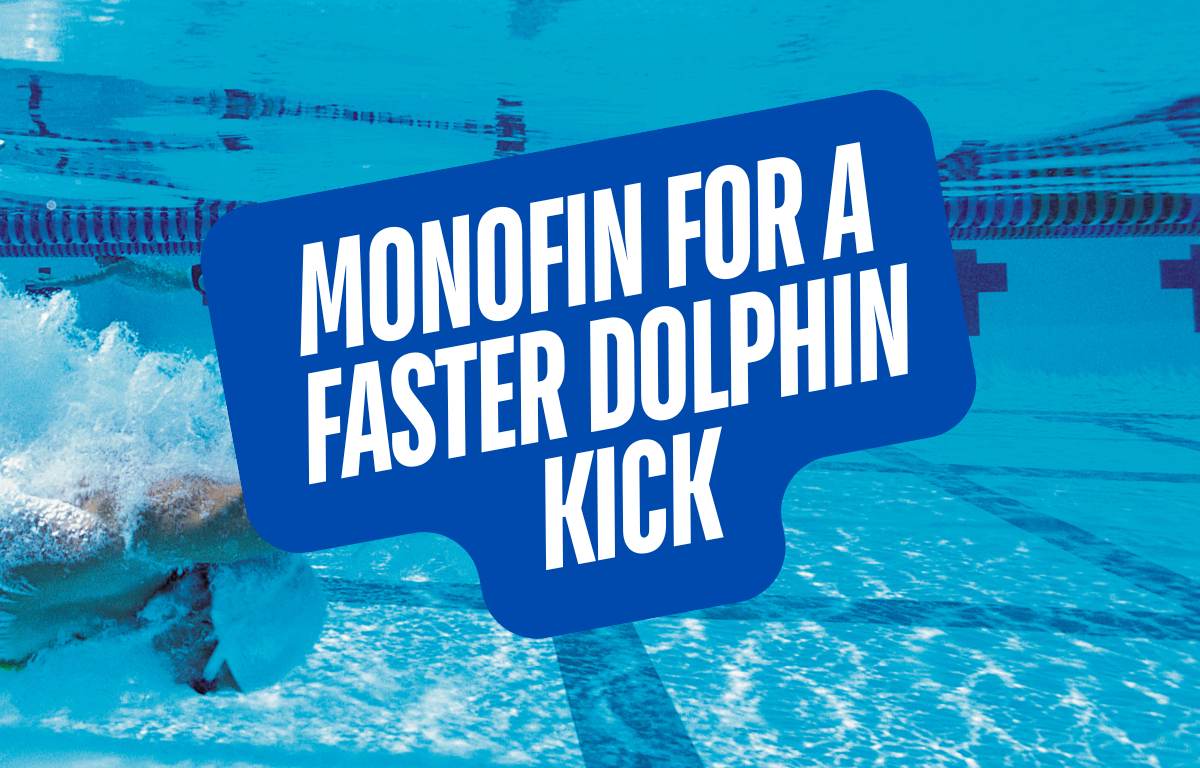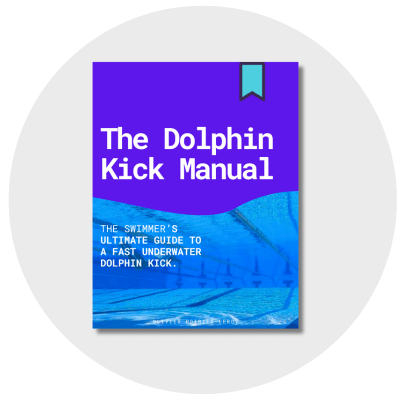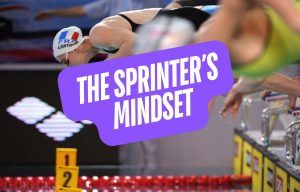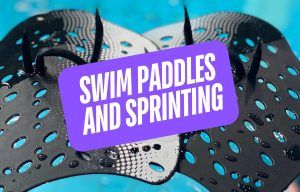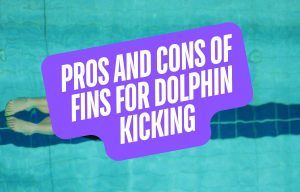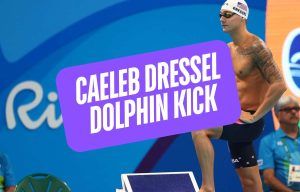A fast and powerful underwater dolphin kick is an essential tool for every enterprising competitive swimmer. A lethal dolphin kick maximizes the speed off the start and turns, is faster than surface swimming, and helps power faster overall results in the pool.
But mastering the timing, coordination, and most importantly, the undulation of efficient dolphin kicking is not easy.
In fact, a survey of elite swim coaches in the UK ranked “timing and coordination” of the movement as the most challenging part of the dolphin kick to coach.
Enter: the monofin!
The monofin is a single blade fin that binds both of your feet together—like you do when dolphin kicking—and forces a more coordination and “undulatory” dolphin kick.
Here’s a breakdown of the benefits of using a monofin for a smoother, more explosive underwater dolphin kick.
How the Monofin Helps Underwater Dolphin Kicking
Here are the ways using a monofin will help you build a faster and more efficient underwater dolphin kick:
- Promotes full-body undulation
- Builds UDK-specific power
- Improves timing and frequency awareness
- Stronger upkick
- Increased kicking speeds
Promotes full-body undulation
The numero uno perk to training with a monofin is that it will teach you how to properly undulate in the water. You don’t really get a choice, after all.
Unlike smaller, short-bladed swim training fins, to move in the water with a monofin strapped to the feet means initiating the movement from the trunk and hips. No knee-directed kicking.
This full-body coordination closely mimics how dolphins kick in the water, and research supports this comparison. A 2011 study by Hochstein & Blickhan described monofin kicking as an intermediate stage between human dolphin kicking and the highly efficient undulation of fish.
“Underwater monofin swimming can be considered as an intermediate stage between aquatic fish swimming and human underwater swimming… Strouhal numbers were about half [compared to no fins]… and close to the optimum for aquatic locomotion.” — Hochstein & Blickhan (2011)
The late swim coach Bob Gillett, a pioneer in advancing the underwater dolphin kick and the coach behind Misty Hyman’s legendary underwaters, used the monofin as a key tool for developing efficient undulation, or as he termed it, the foil movement.
This movement is all about precise, full-range kicking powered by a combo of knee extension, lots of ankle flexibility, and core-drive wave motion. Which the monofin naturally promotes with every kick.
Builds UDK-specific power
The large surface area of the monofin creates a lot of resistance (which, fun fact, also leads to increased kicking velocities), building strength in the muscle groups that power the dolphin kick.
The glutes, hamstrings, erector spinae, and quads work hard to power the kick. The larger blade of the monofin also forces the ankles, including the tibialis anterior and calves, to work hard to achieve propulsion.
The monofin sets swimmers up to develop the muscular capacity to kick with greater force and control. And because the motion is continuous and low-impact, they allow for powerful training without destroying the joints.
Improves timing and frequency awareness
Fast dolphin kicking is more than just power and super flexible ankles, although those things certainly help. Rhythm and control are crucial to create an efficient kicking pattern that smoothly generates vortices that swimmers use for propulsion.
The monofin’s increased resistance and unified motion slow down the kick cycle (resistance always slows down the movement, whether you are using a drag chute, paddles, or in this case, a huge blade attached to your feet!), which can make it easier to feel each phase and transition of the kick.
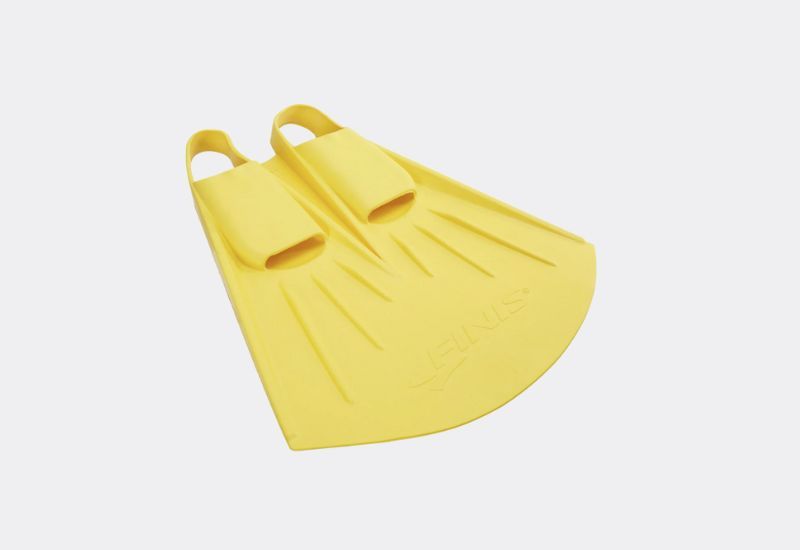
Mastering the timing of the kick, including kicking smoothly through transitions and identifying where frequency/timing falls off can be very illuminating in knowing where to spend your time and focus on improving the UDK.
Stronger upkick
The upkick phase of the underwater dolphin kick—where the bottoms of the feet drive water “up” towards the surface—is a criminally under-trained aspect of the UDK. It’s also where most swimmers can accelerate improvement the fastest.
The monofin’s large blade forces you to kick (relatively) evenly in both directions. This is especially true during fish kicking (kicking on your side), where symmetrical undulation is key.
Unlike smaller fins or going fin-less, which can disguise an uneven kick, the monofin is brutally honest about weaknesses in the upkick. If the motion is sluggish or underpowered, the large blade of the monofin will let you know.
While the downkick will always be the dominant source of propulsion, research by Atkinson et al. (2014) on elite swimmers showed that a fast and effective upkick was the strongest predictor of overall kicking velocity.
In other words, training a better upkick isn’t just complementary, it’s essential. And the monofin can help you get snappier and stronger with it.
Increased kicking speeds
Okay, let’s talk straight-up velocity: a monofin will send you absolutely ripping through the depths of the pool. Which, if we are being honest, is flat-out fun.
Hochstein & Blickhan (2011) compared dolphin kicking with and without a monofin, and quelle surprise, the monofin mopped the floor with fin-less kicking.
Swimmers using a monofin reached speeds of 2.5 meters per second (which is 0.3m/s faster than Cam McEvoy’s surface swimming speed when he won gold at the Paris Olympics). Without the monofin, swimmers kicked 1.2m/s, halving velocity.
Note: Interestingly, the kick frequency and amplitude were largely the same between the two conditions.
Kicking at overspeed velocities with a monofin allows swimmers to experience what highly efficient underwater movement truly feels like: smooth, powerful, and fast.
This sensation helps them internalize optimal technique, reinforcing the neuromuscular patterns needed to replicate that speed and efficiency during regular training and racing.
The Bottom Line
Improving the dolphin kick is one of the best things swimmers can do to post faster times on the scoreboard. It’s also highly rewarding.
There’s nothing quite like mastering the flow and full-body movement of undulation, soaring through the depts at faster-than-swimming speeds, and exploding to the surface at high velocities.
Adding a monofin to your dolphin kick training stack is an excellent way to go about fine-tuning the body-wave motion, cleaning up clunky kicking, and spicing up your underwaters.
When you head to the pool today, and you push off or dive in, don’t sleep on the upkick!
The Ultimate Guide for a Faster Underwater Dolphin Kick
Want help leveling up your underwater dolphin kick? The Dolphin Kick Manual is the ultimate resource for helping swimmers and swim coaches develop a world-class underwater dolphin kick.

The Dolphin Kick Manual is a beastly 240+ pages of actionable insights and research into elite dolphin kicking technique and performance. It details everything from mastering undulation to vortex recapturing to structuring a dryland program for dolphin kicking success.
It combines evidence-based insights with a collection of 20 ready-to-go sets and a 6-week Action Plan to help swimmers set a course for dolphin kicking success.
Train smarter and kick faster.

